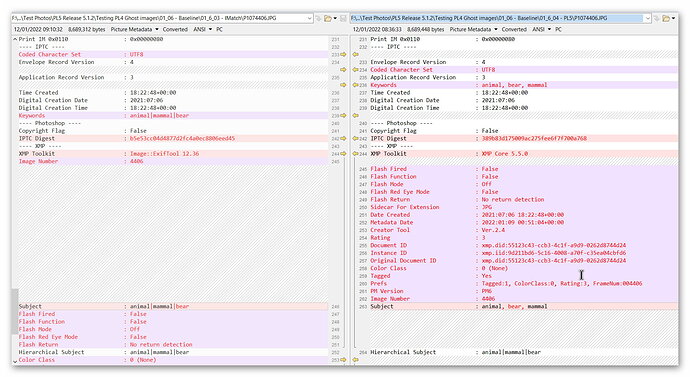@joanna I am a little concerned that I have not fully understood the rules that you are proposing!? During Beta testing this was mostly new to me, I had never used a hierarchical keyword in my life so the way that I went about testing was to compare various programs and the way that they handled various scenarios to see if I could understand the logic.
I restarted that process in the my post above; I was always concerned about mixing PL5 with its “apparent” obsession with ‘hr’ keywords (subject) with ‘dc’ only programs, Adobe Bridge in this test.
So I used one program IMatch to compare the results with PL5 and also to see how your proposals stack up against what these programs are doing with the data. The comparison is Test 2 - animal|mammal|bear and Test 4 - animal, mammal, bear and animal|mammal|bear all explicitly added by the user (me), principally to see what happens!
One problem I had back in Beta testing was that using this approach threw up more inconsistencies than I expected, if we add your proposals then things get even more complicated. So for test 2 we have
IMatch PL5
Subject animal|mammal|bear animal, bear, mammal
Hierarchical Subject animal|mammal|bear animal|mammal|bear
IMatch fails to include the flattened keywords in the ‘dc’ Subject which PL5 has included but PL5 leaves out the hierarchical key from the Subject field and, as a consequence ‘dc’ only programs have no sight/idea of the hierarchical nature of the keywords!
Surely for compatibility the Subject must also contain animal|mammal|bear? Hence, in this case shouldn’t the keywords be Subject = animal, mammal, bear, animal|mammal|bear and HR Subject =animal|mammal|bear?
When we get to Test 4 with the “overloaded” set of keywords we have
IMatch PL5
Subject animal, mammal, bear animal, mammal, bear
animal|mammal|bear
Hierarchical Subject animal, mammal, bear animal, mammal, bear
animal|mammal|bear animal|mammal|bear
Based upon your “recommendation” you would suggest that the flat keys have no place in the HR Subject (it does make sense) but I would suggest that animal|mammal|bear should be present in the Subject field to maintain compatibility with ‘dc’ programs. During Beta testing I declared such a key in Bridge and by the time that PL5/LR had finished with the photo the displayed photo in Bridge no longer had the (hierarchical) keyword that Bridge had assigned to it!!??
The other comparisons that I can make show what an absolute “pig’s breakfast” this area is, we may criticise DxO for not getting it “right” (and they had plenty of expertise to tap into) but I am not impressed with what some of the other programs are doing with keywords either! I am not a standards expert but when I see a keyword “vanish” from Bridge I feel that something has gone very wrong!


